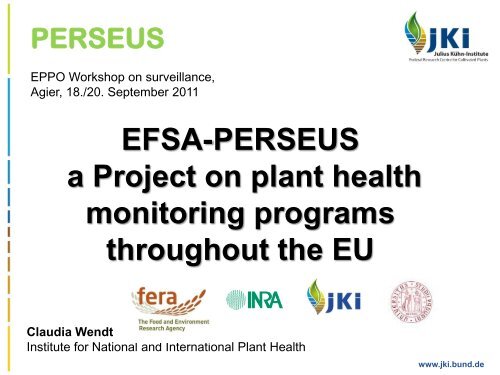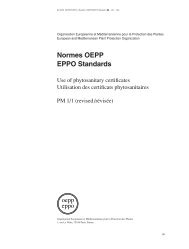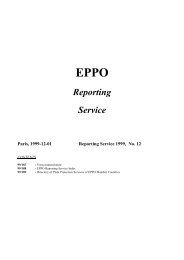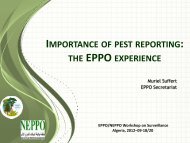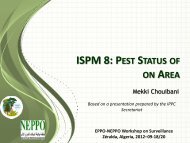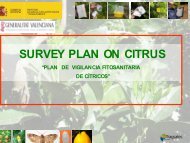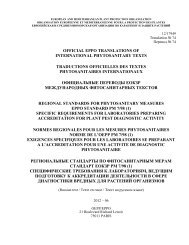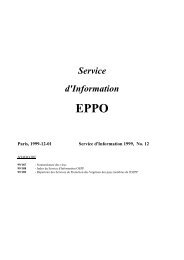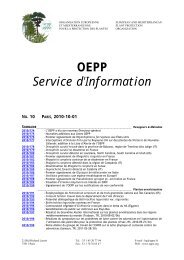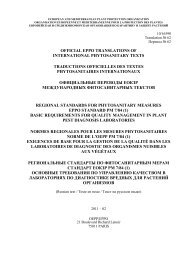EFSA-PERSEUS a Project on plant health monitoring programs ...
EFSA-PERSEUS a Project on plant health monitoring programs ...
EFSA-PERSEUS a Project on plant health monitoring programs ...
Create successful ePaper yourself
Turn your PDF publications into a flip-book with our unique Google optimized e-Paper software.
<str<strong>on</strong>g>PERSEUS</str<strong>on</strong>g><br />
EPPO Workshop <strong>on</strong> surveillance,<br />
Agier, 18./20. September 2011<br />
<str<strong>on</strong>g>EFSA</str<strong>on</strong>g>-<str<strong>on</strong>g>PERSEUS</str<strong>on</strong>g><br />
a <str<strong>on</strong>g>Project</str<strong>on</strong>g> <strong>on</strong> <strong>plant</strong> <strong>health</strong><br />
m<strong>on</strong>itoring <strong>programs</strong><br />
throughout the EU<br />
Claudia Wendt<br />
Institute for Nati<strong>on</strong>al and Internati<strong>on</strong>al Plant Health<br />
www.jki.bund.de
The <str<strong>on</strong>g>PERSEUS</str<strong>on</strong>g> c<strong>on</strong>sortium<br />
4 Partners – 4 countries<br />
Research<br />
• FERA – UK<br />
• INRA - FR<br />
• JKI – DE<br />
Subc<strong>on</strong>tractor<br />
• UPAD - IT<br />
Management<br />
• FERA - UK<br />
FERA<br />
INRA<br />
JKI<br />
UPAD<br />
www.jki.bund.de
<str<strong>on</strong>g>PERSEUS</str<strong>on</strong>g> major goals<br />
Plant <strong>health</strong> surveys for the EU territory: an analysis of data quality<br />
and methodologies and the resulting uncertainties for<br />
pest risk assessment .<br />
Identify limitati<strong>on</strong>s in<br />
survey methodology<br />
On the basis of this<br />
knowledge improve PRAs<br />
and survey methodologies<br />
Reduce the level<br />
of risk for the EU territory<br />
• Taking advantage of the transnati<strong>on</strong>al dimensi<strong>on</strong> of <str<strong>on</strong>g>PERSEUS</str<strong>on</strong>g><br />
www.jki.bund.de
Divisi<strong>on</strong> of work<br />
WP 1: Systematic literature<br />
review<br />
WP 2: Inventory of specific<br />
surveys<br />
WP 3: Review of<br />
methodologies<br />
WP 4: Case studies<br />
• Gather informati<strong>on</strong><br />
• Search in scientific articles, c<strong>on</strong>ference<br />
proceedings, dissertati<strong>on</strong>s, research projects<br />
and grey literature<br />
• Questi<strong>on</strong>naires<br />
• Search of database CIRCA EUROPHYT<br />
• WP1 and WP2 findings are reviewed<br />
• Uncertainty factors in methodologies<br />
are outlined and quantified<br />
• Evaluate survey methodologies for 24<br />
species in more detail<br />
www.jki.bund.de
Results of WP 1<br />
Systematic literature search, procedure<br />
Species list (Annexes I and II of Directive 2000/29/EC)<br />
1) Detecti<strong>on</strong><br />
2) Delimitati<strong>on</strong><br />
3) M<strong>on</strong>itoring<br />
4) Commodity surveys<br />
TRADITIONAL REVIEW<br />
Search protocol according to <str<strong>on</strong>g>EFSA</str<strong>on</strong>g><br />
guidelines<br />
DATABASE OF THE CASES and data analysis<br />
www.jki.bund.de
Results of WP 1<br />
Documents analysed <strong>on</strong> September 2012 for validated<br />
species in main categories of organisms<br />
Organism retrieved retained added used<br />
Bacteria 8777 2209 20 439<br />
Fungi 8654 1835 56 640<br />
Insects 23540 5440 40 1910<br />
Nematodes 3525 1156 17 303<br />
Phytoplasmas 1234 431 9 164<br />
Viruses 7709 3949 21 1354<br />
Total 53439 15020 163 4810<br />
Documents used for producti<strong>on</strong> of 242 summaries<br />
www.jki.bund.de
WP 2, inventory of specific surveys<br />
Two types of questi<strong>on</strong>naires were created<br />
1. Identify authorities and experts working in the field of <strong>plant</strong> <strong>health</strong>, that<br />
were c<strong>on</strong>ducting surveys <strong>on</strong> species regulated in COUNCIL DIRECTIVE<br />
2000/29/EC and those species subject to emergency and c<strong>on</strong>trol directives<br />
measures<br />
2. On surveys carried out <strong>on</strong> the 25 key species, obtained from<br />
questi<strong>on</strong>naire 1 resp<strong>on</strong>ses and surveyed by more than 5 countries<br />
www.jki.bund.de
Results of WP 2<br />
Questi<strong>on</strong>naires<br />
Of the 17 addressed countries,<br />
13 resp<strong>on</strong>ded to questi<strong>on</strong>naire<br />
two.<br />
76,5%<br />
All 25 species were represented<br />
• AT<br />
• BE<br />
• BG<br />
• EE<br />
• FI<br />
• DE<br />
• GR<br />
• ME<br />
• NO<br />
• PL<br />
• IE<br />
• SK<br />
• SE<br />
• GB<br />
www.jki.bund.de
Results of WP 2<br />
Questi<strong>on</strong>naires and Grey literature<br />
• Nati<strong>on</strong>al guidelines or standard operating procedures<br />
• 85 documents including 2 draft SOPs<br />
• Different approaches to the necessary of such nati<strong>on</strong>al documents<br />
a) Extra guidelines for each species<br />
b) Sector wise approach<br />
c) One compendium for all relevant species<br />
• Search for Grey literature<br />
• Covered all species as well as all countries<br />
• Findings c<strong>on</strong>sists of dossiers <strong>on</strong> single species legislative documents and<br />
relevant articles in professi<strong>on</strong>al journals<br />
• Grey literature findings: 18 species out of 24<br />
• About 200 entries<br />
www.jki.bund.de
WP 3<br />
Review of methodologies<br />
Genera<br />
Number of<br />
species<br />
Technical guidelines<br />
available<br />
Retrieved from<br />
literature review<br />
Bacteria 5 12 838<br />
Fungi 3 12 180<br />
Insects 9 29 447<br />
Nematodes 6 12 788<br />
Phytoplasmas 1 3 150<br />
Viruses 4 17 661<br />
Total 28 85 3064<br />
www.jki.bund.de
WP 4<br />
Case studies<br />
• C<strong>on</strong>sisting task<br />
• List of 25 species, current relevance for the EU, representative cross secti<strong>on</strong><br />
a) All types of surveys<br />
b) All genera of quarantine pests<br />
c) PRA available<br />
• Details of survey methodologies are scrutinised e.g. timing, scope,<br />
sampling procedure, diagnostic procedure and the reporting of survey<br />
results<br />
www.jki.bund.de
Species list for WP 3 and 4<br />
Species Genera Type of survey PRA Case study<br />
Anoplophora chinensis Insect Detecti<strong>on</strong> / Commodity Available Yes<br />
Anoplophora glabripennis Insect Detecti<strong>on</strong> / Commodity Not available No<br />
Tomato spotted wilt Virus Virus Detecti<strong>on</strong> / Commodity Not available No<br />
Xanthom<strong>on</strong>as fragariae Bacterium Detecti<strong>on</strong> / Commodity Not available No<br />
Xanthom<strong>on</strong>as campestris Bacterium Detecti<strong>on</strong> / Commodity Not available No<br />
Rhynchophorus<br />
ferrugineus Insect Detecti<strong>on</strong> / Commodity Available Yes<br />
Erwinia amylovora Bacterium Detecti<strong>on</strong> / M<strong>on</strong>itoring Available Yes<br />
PepMv Virus Detecti<strong>on</strong> / M<strong>on</strong>itoring Available Yes<br />
Apple proliferati<strong>on</strong> Phytoplasma M<strong>on</strong>itoring Available Yes<br />
www.jki.bund.de
Species list for WP 3 and 4<br />
Species Genera Type of survey PRA Case study<br />
Clavibacter michiganensis ssp.<br />
seped<strong>on</strong>icus Bacterium M<strong>on</strong>itoring Not available Yes<br />
Globodera pallida Nematode M<strong>on</strong>itoring Available Yes<br />
Globodera rostochiensis Nematode M<strong>on</strong>itoring Available Yes<br />
Plum Pox Virus Virus M<strong>on</strong>itoring Available Yes<br />
Phytophthora ramorum Fungus M<strong>on</strong>itoring Available Yes<br />
Synchytrium endobioticum Fungus M<strong>on</strong>itoring Available Yes<br />
Bemisia tabaci Insect Detecti<strong>on</strong> Not available Yes<br />
Bursaphelenchus xylophilus Nematode Detecti<strong>on</strong> Available Yes<br />
Diabrotica virgifera Insect Detecti<strong>on</strong> Available Yes<br />
Ditylenchus dipsaci Nematode Detecti<strong>on</strong> Not available No<br />
Ditylenchus destructor Nematode Detecti<strong>on</strong> Not available No<br />
www.jki.bund.de
Species list for WP 3 and 4<br />
Species Genera Type of survey PRA Case study<br />
Dryocosmus kuriphilus Insect Detecti<strong>on</strong> Available Yes<br />
Gibberella circinata Fungus Detecti<strong>on</strong> Available Yes<br />
Leptinotarsa decemlineata Insect Detecti<strong>on</strong> Available Yes<br />
Liriomyza Insect Detecti<strong>on</strong> Available Yes<br />
Meloidogyne chitwoodi Nematode Detecti<strong>on</strong> Not available No<br />
Meloidogyne fallax Nematode Detecti<strong>on</strong> Not available No<br />
PSTVd Virus Detecti<strong>on</strong> Available Yes<br />
Ralst<strong>on</strong>ia solanacearum Bacterium Detecti<strong>on</strong> Not available No<br />
Thrips palmi Insect Detecti<strong>on</strong> Available Yes<br />
www.jki.bund.de
Thank you for your<br />
attenti<strong>on</strong>.<br />
Claudia Wendt<br />
Julius Kühn – Institute, Kleinmachnow<br />
Germany<br />
www.jki.bund.de


